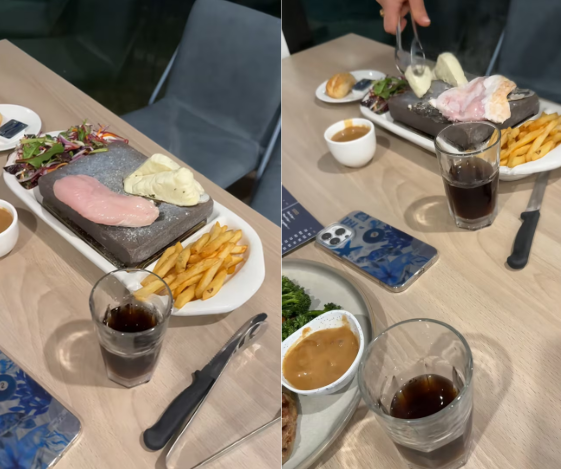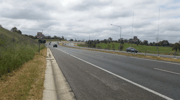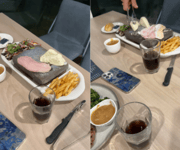
A night out at a Central Coast RSL has sparked a fiery debate about what belongs on our dinner plates.
One viral clip of a family meal has left viewers divided—some calling it a health disaster waiting to happen, others praising it as a dining experience with ancient roots.
What unfolded at a Gorokan club has now ignited a nationwide conversation about food safety, culture, and trust in the places we eat.
The video in question was filmed by creator Fidan Shevket, known as Fidantok, while dining with family at Wallarah Bay Recreation Club last Saturday night.
Her camera captured her brother John with a large raw chicken breast on a sizzling volcanic stone beside chips and salad, part of a $36 meal ($30 for members).
‘That’s what my brother is having,’ she said, before showing the full spread that came with the promise of cooking your own meat on a ‘natural volcanic stone heated to 400 degrees.’
The footage, now seen more than 300,000 times, showed John using the same tongs on raw chicken and halloumi cheese—an image that set alarm bells ringing for many viewers.
'What in the salmonella hell is that? We're getting too fancy with it now. It's one thing to cook it at Korean BBQ, but a hot stone with raw chicken at the pub, I can't.'
Food safety concerns
The concern went far beyond squeamishness.
Cross-contamination occurs when harmful bacteria move from raw foods like poultry to cooked or ready-to-eat items.
With more than 5 million cases of food poisoning in Australia every year, the sight of raw chicken close to salad struck many as a genuine hazard.
Australian food safety temperature guidelines
The 'temperature danger zone' for food safety is between 5°C and 60°C.
At these temperatures bacteria that cause food poisoning can grow to unsafe levels that can make you sick. [3]
Hot food should be kept above 60°C, while the club's stones reach 400°C—well above the danger zone.
Australian food safety guidelines advise separate utensils, chopping boards, and knives for raw meat and foods that will not be cooked.
This detail, missing in the viral clip, is what unsettled so many people watching from home.
The club’s response
Wallarah Bay Recreation Club responded quickly to the criticism.
A spokesperson explained that customers always received instructions to cook their meat thoroughly, with reminders given to repeat diners as well.
They stressed that the venue held a five-star local food authority rating, was ‘100 per cent compliant’, and only served boneless butterflied chicken so it would cook evenly.
The venue also revealed the meal’s popularity, noting they served up to 180 stone grills on busy nights and had never received a formal complaint.
The reality is that food businesses across Australia are legally bound to follow strict standards to protect diners.
RSLs and recreation venues fall under these rules, with high-risk operations classified in Category 1, where handling raw and ready-to-eat foods demands extra care.
While customer education aligns with these laws, experts highlight the critical need for strict utensil separation and hygiene in any food preparation setting.
Cooking tradition with ancient roots
Beyond regulations, hot stone cooking is not new.
It rose in popularity in the late 1990s and early 2000s, drawing from traditions of cooking meat on volcanic rock that stretch back thousands of years.
Did you know?
Volcanic stone cooking has ancient origins Volcanic stone cooking has been used by indigenous cultures for thousands of years. The porous nature of volcanic rock allows it to retain and distribute heat evenly, making it ideal for cooking meat to consistent temperatures.
Many cultures feature similar practices, from Korean barbecue to South American parrillas, each with unique safety measures.
Not all viewers were horrified by the viral clip either.
‘Stone grills are actually really good,’ one defender wrote.
Another added with humour: ‘You will be shocked to discover that regular cooked chicken dishes also started as raw chicken.’
What this means for diners
The club’s menu also offered stone-grilled eye fillet and barramundi, showing that the appeal stretched well beyond chicken.
For diners, the lesson was clear—hot stone meals can be enjoyable, but only when handled with proper knowledge and care.
Australia’s safe food supply is among the best in the world, yet around one in five Australians still experienced illness from incorrectly handled food.
The viral RSL moment showed just how quickly social media can turn a single meal into a national talking point—and how traditional dining methods can feel surprising when framed in a modern light.
What This Means For You
A viral video of diners cooking raw chicken at an RSL has split Australians, with many raising concerns about whether such a meal belongs in a club setting. Food safety experts pointed out the risks of cross-contamination, especially when utensils are shared between raw and ready-to-eat foods.
Wallarah Bay Recreation Club defended the practice, noting they provide clear instructions to diners and hold strong compliance ratings with local food authorities. While hot stone cooking has ancient roots and remains a unique dining experience, it also demands strict safety protocols in modern settings to protect diners.
For older Australians who often rely on their local RSLs as a trusted place for meals and community, this debate is a timely reminder to stay alert to food safety practices—whether dining out or cooking at home.
Food safety concerns don’t just end at the dinner table—sometimes the risks come straight from the products we bring home.
Recent recalls have shown how quickly issues with contamination or labelling can impact what ends up in our kitchens.
If the viral RSL hot stone meal made you think twice about safe food handling, this next case highlights another side of the same issue.
Read more: Back-to-back food recalls spark urgent nationwide warning
Food safety | healthdirect — Explains how cross-contamination occurs when bacteria or viruses transfer from raw foods like chicken to other items.
https://www.healthdirect.gov.au/food-safety
Food standards and safety | Australian Government Department of Health, Disability and Ageing — Notes there are over 5 million cases of food poisoning each year, despite strict standards.
https://www.health.gov.au/topics/food-and-nutrition/about/food-standards-and-safety
Food safety | healthdirect — Details the 'temperature danger zone' between 5°C and 60°C where bacteria can rapidly multiply.
https://www.healthdirect.gov.au/food-safety
Food safety basics | Food Standards Australia New Zealand — Highlights how microorganisms from raw meat and poultry can spread to fruits, vegetables, and ready-to-eat foods.
https://www.foodstandards.gov.au/consumer/prevention-of-foodborne-illness/food-safety-basics
Food safety basics | Food Standards Australia New Zealand — Advises using separate cutting boards and knives for raw meats and foods that will not be cooked.
https://www.foodstandards.gov.au/consumer/prevention-of-foodborne-illness/food-safety-basics
Food standards and safety | Australian Government Department of Health, Disability and Ageing — Outlines how businesses are legally required to follow food safety standards to prevent illness.
https://www.health.gov.au/topics/food-and-nutrition/about/food-standards-and-safety
Food Safety in Australia: How to Implement Food Standards Code? — Explains that Category 1 food businesses, such as caterers and food services, face stricter safety rules.
https://www.fooddocs.com/post/food-safety-in-australia
Food Safety in Australia: How to Implement Food Standards Code? — States that separate utensils and equipment must be used when preparing raw and ready-to-eat foods.
https://www.fooddocs.com/post/food-safety-in-australia
Food Safety in the Kitchen | Nutrition Australia — Warns that around 1 in 5 people experience illness due to incorrectly cooked, stored, or handled food.
https://nutritionaustralia.org/division/nsw/food-safety-in-the-kitchen/
Would you feel confident cooking raw chicken on a hot stone at your local club, or does the thought alone make you lose your appetite?







